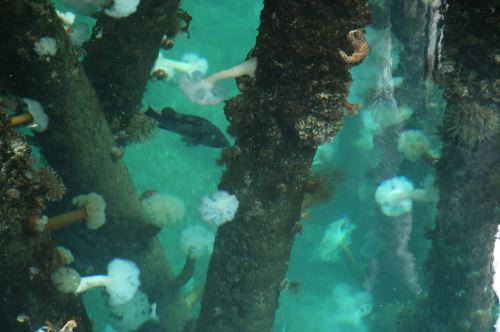What a busy couple of days we have had here on the Knorr. We have been crisscrossing the shelf following a plankton bloom we can see from the MODIS satellite. MODIS, which stands for Moderate Resolution Imaging Spectroradiometer, is a key instrument aboard both the Terra and Aqua satellites. Terra's orbit around the Earth is timed so that it passes from north to south across the equator in the morning, while Aqua passes south to north over the equator in the afternoon. Terra MODIS and Aqua MODIS are viewing the entire Earth's surface every 1 to 2 days, acquiring data in 36 spectral bands, or groups of wavelengths. A big area of interest in oceanography is ocean color. Because the world’s oceans are so vast it can be hard to monitor them on a large scale. Using satellites is ideal because they can profile large swaths of the ocean at any one time. Changes in the oceans color as seen from space can give scientists a good estimation of what’s going on in terms of productivity. The problem with using satellite information here on the Bering Sea is the fact that it cannot see through clouds. Well, guess what we get up here on the Bering Sea, clouds. It’s great when we get a clear or not so overcast day because then we can make good use of MODIS information.
One of the U.S. Fish and Wildlife people onboard, Liz Lubunski took some great pictures of birds and wildlife and I thought I would share them with you. She is one of the two people (the other is Sophie Wells) who are doing a survey of birds here on the Bering Sea. Liz had to get of at St. Paul Island but Sophie is still onboard and is continuing the survey. Both have tremendous knowledge of the local birds life and great eyes, plus better cameras then I have to get those better shots. There is a great diversity of life up here in Alaska. The picture of the Metridium anemones growing on the piling was taken right at the pier where the Knorr was docked.
 Growing on the Pillings
Growing on the Pillings
Growing on the pier pilings
She was also able to get some pictures of the American Dipper (Cinclus mexicanus), which makes its living catching small invertebrates in fast moving streams and the Lapland Longspur (Calcarius lapponicus), which summers in extreme northern Canada and Alaska.
 American Dipper
American Dipper
American Dipper
 Lapland Longspur03
Lapland Longspur03
Lapland Longspur
The one bird I get asked about the most is the Albatross. Well here are a couple of shots of some Laysan Albatross (Phoebastria immutabilis) we saw while on station. They tend to stay away from the ship but Liz was able to the pictures with a telephoto lens. These particular birds traveled here to the Bering Sea from the Hawaiian Archipelago.
 LaysanAlbatross02
LaysanAlbatross02
Laysan Albatross
They feed mostly on cephalopods such as squid. In recent years there has been a problem with these birds picking up pieces of plastic from the ocean, mistaking it for food and feeding the plastic to their chicks, which frequently causes them to starve to death.
 LaysanAlbatross01
LaysanAlbatross01
Another Laysan Albatross
Unfortunately there is way too much plastic in the ocean and this is really having a deleterious effect upon marine life. From sea birds to turtles, many organisms are adversely harmed by our improper disposal of plastics. Please keep that in mind next time you are shopping. Be aware of how much plastic and packaging we are buying because unfortunately some of this makes its way into our marine ecosystems.
Thanks again for the pictures Liz!

